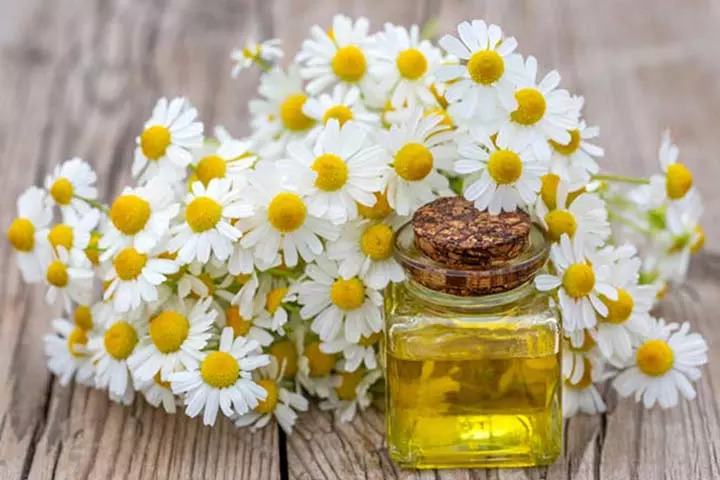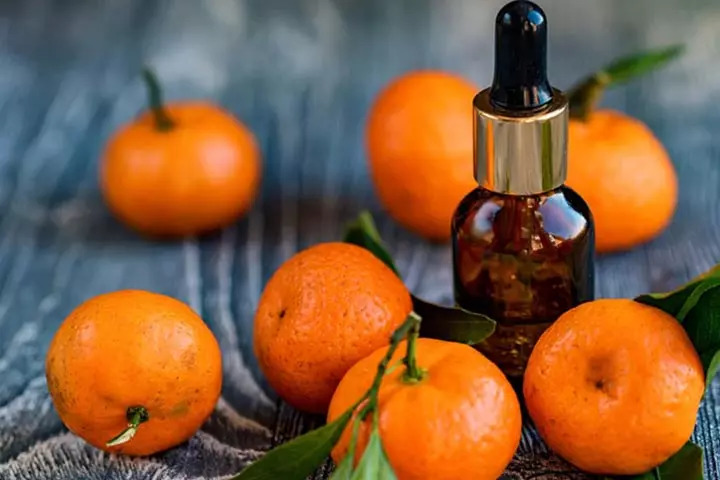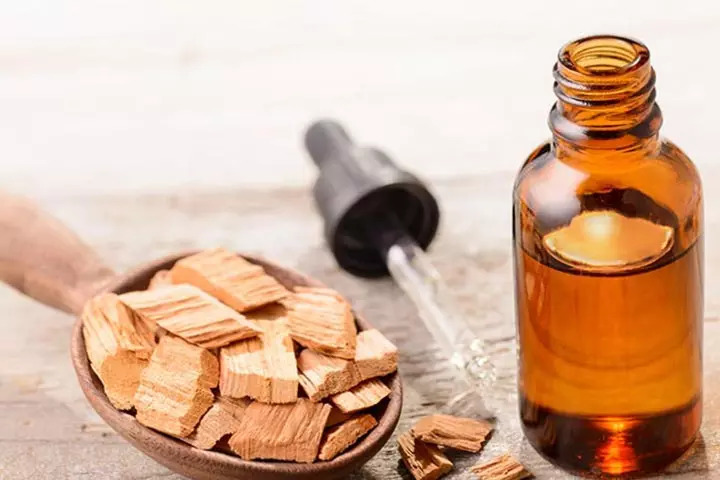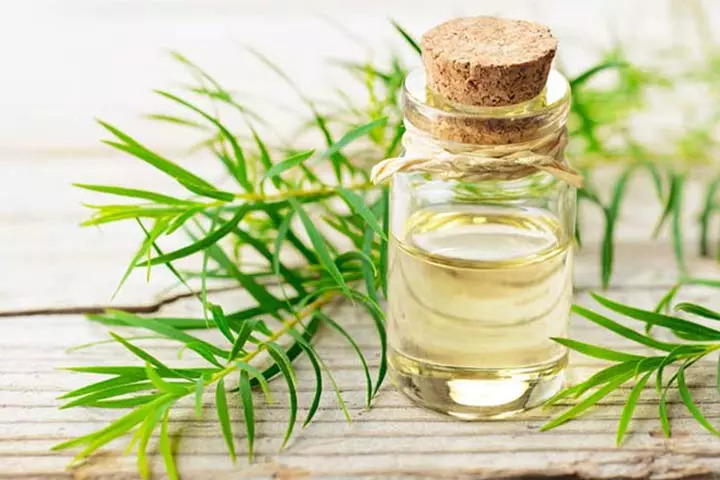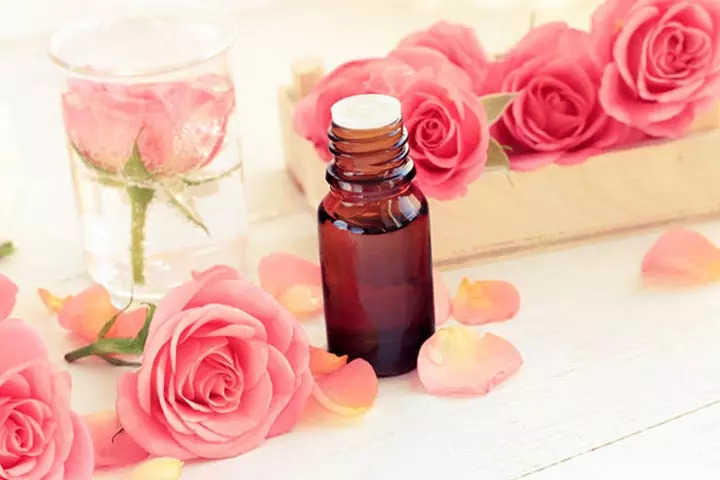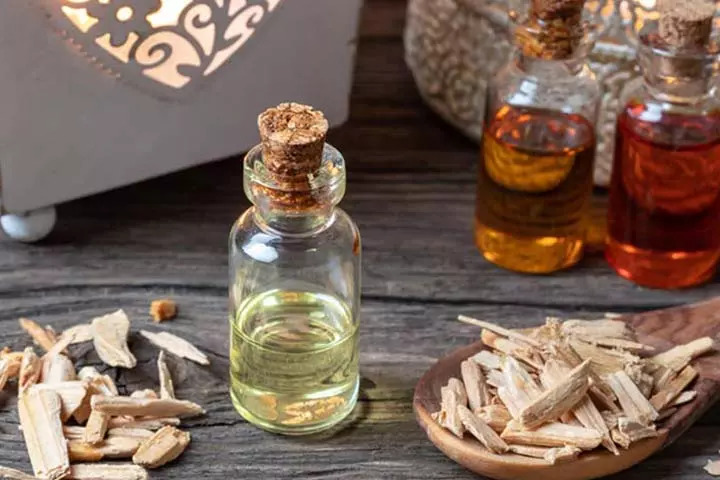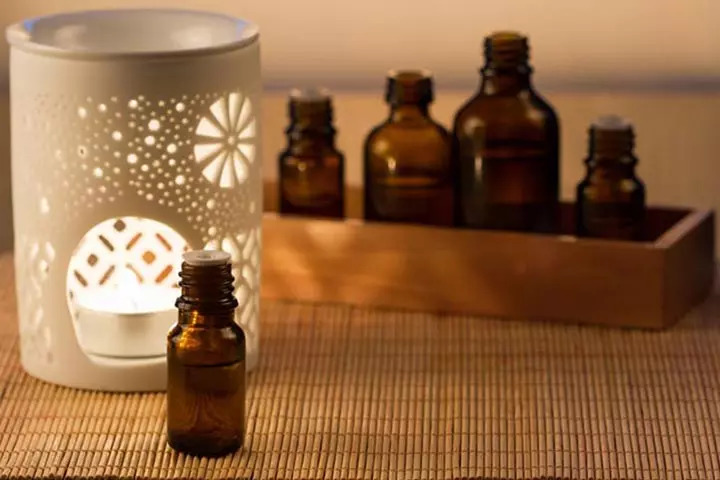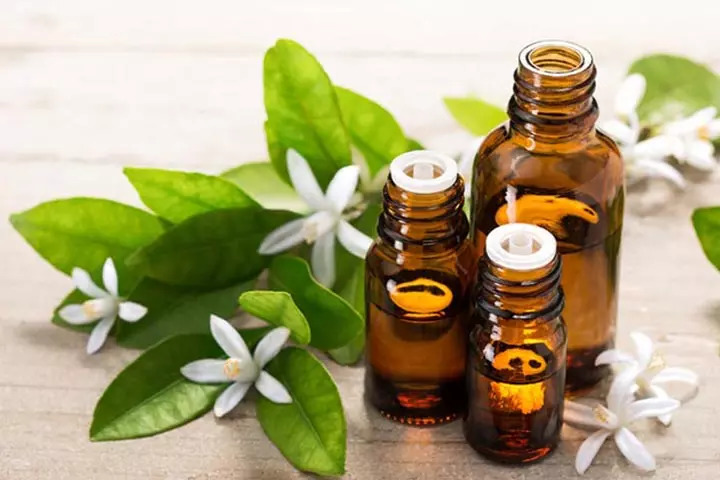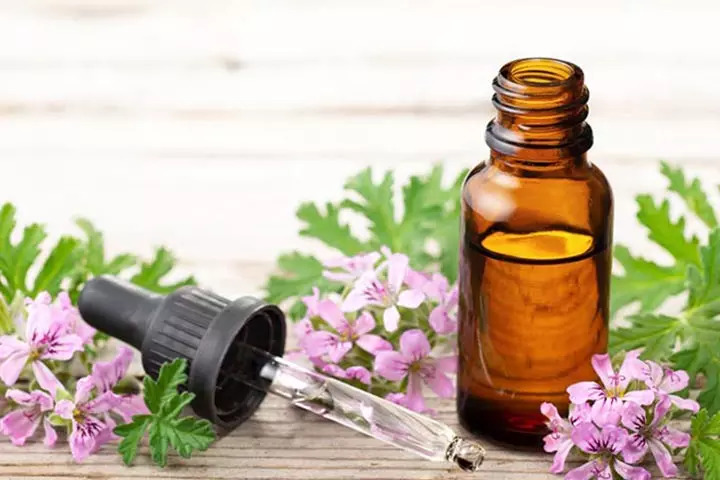Essential oils possess several therapeutic and medicinal properties. While you can use essential oils for babies for aromatherapy and general purposes, you must be aware of some basic guidelines to prevent adversities.
Essential oils are fragrant, concentrated oils extracted from various plant parts, such as leaves, flowers, seeds, barks, or fruits. Always use them under the guidance of a certified herbalist or aromatherapy professional to know the right dosage and methods for using them.
Keep reading as we offer you an overview of essential oils for babies, their safety, the right age to use them, and some precautions to avoid any adverse effects.
Are Essential Oils Safe For Babies?
When used correctly, essential oils can be safe and offer several benefits to babies. However, it is better to use child-friendly, edible, plant-based oils, such as sweet almond oil, unscented coconut oil, and sesame oil, without any smell on a baby’s delicate skin. This is because babies often end up licking or sucking their body parts. Also, any kind of smell can overstimulate a baby’s senses and nervous system.
If you are planning to use essential oils for your baby’s wellness, it is good to consult a certified aromatherapist or essential oil practitioner.
What Is The Right Age To Use Essential Oils For Babies?
Young babies have thin, permeable skin that is sensitive to essential oils (2). Therefore, using EOs for babies younger than three months is not advisable. When it comes to babies older than three months, the essential oil’s type and intended use determine the right age for its use. Speak to an essential oil expert to learn if a specific essential oil is suitable for your baby’s age (1) (2).
Which Essential Oils Are Safe For Babies?
Here is a list of 12 essential oils you can use for your baby after consulting your healthcare provider.
1. Lavender (Lavandula angustifolia)
Lavender oil has a calming effect on the body and mind, resulting in an improvement in overall mood. You may apply it on babies older than three months to reduce pain, alleviate coliciXPeriodic and predictable crying episodes in infants for an extended period with no definitive causesymptoms, and promote sleep (3) (4) (5). Massaging and diffusion are two ways to use lavender oil for babies (2).
2. Dill (Anethum graveolens)
Dill essential oil is rich in bioactive compounds, such as carvone, limonene, and phenols (6). The oil has carminative (reduces gas) and antispasmodic (reduces muscle spasms) properties, which may help relieve colic symptoms in babies (7). You can use dill oil to massage your baby in the morning or evening.
3. Chamomile (Matricaria recutita or Chamaemelum nobile)
Chamomile is an ancient medicinal herb with two popular varieties — German and Roman chamomile. Both these varieties are used in making EOs. Massaging infants with chamomile oil may increase their sleep duration and reduce colic symptoms (8) (9). Roman chamomile’s essential oil may also be effective against boils, sunburn, diaper rash, and cold sores (10).
4. Mandarin (Citrus reticulata)
Mandarin oil has a sweet fragrance that feels pleasantly calming. It is usually safe for babies older than six months (2). Massaging your baby with mandarin oil at bedtime can help them sleep peacefully. Also, it has antibacterial and antifungal properties that may keep the skin healthy (11).
5. Sandalwood (Santalum album)
Sandalwood EO is a common ingredient in several alternative medicines, perfumes, and cosmetics. The essential oil has a calming effect that helps reduce anxiety and insomniaiXA sleep disorder that makes it difficult for one to fall asleep, stay asleep, or get a sound sleep(12). Also, it has anti-inflammatory, antioxidant, and antibacterial properties that may keep the infant’s skin healthy (13).
6. Tea Tree (Melaleuca alternifolia)
Tea tree oil has antimicrobial, antifungal, and antioxidant properties (14). Its topical use could relieve abscessiXA swollen area filled with pus that can develop anywhere in the body, often caused by an infection, cold sores, burns, insect bites, and dandruff, and its inhalation by diffusion may alleviate respiratory problems, such as cough (15). Diluted tea tree oil is safe to use for babies older than six months.
7. Rose Otto (Rosa damascena)
Rose otto, also known as Damask rose, is a refreshing essential oil that calms the senses. Using natural remedies such as massaging babies over six months with rose otto oil may help alleviate pain and reduce anxiety. Also, it has antibacterial and antifungal properties that may alleviate skin problems. Its vapor may help ease and manage certain allergies (16).
8. Cedarwood (Cedrus atlantica, Cedrus deodara, and Juniperus virginiana)
Cedarwood EO comes from steam distilling the needles, leaves, bark, berries of true cedar, juniper, and cypress. The deep and earthy fragrance of this scented oil relaxes the body and the mind, and inhaling it could alleviate insomnia and anxiety (17) (18). You can diffuse cedarwood oil for babies as its topical use is generally inadvisable.
9. Palmarosa (Cymbopogon martinii)
Palmarosa EO has a refreshing floral scent, which gives a soothing feeling. It has astringentiXA substance or property that causes contraction or tightening of tissues, typically used in skin care products, antibacterial, and antioxidant properties due to which its use is common for skincare purposes (2) (19). You can use palmarosa oil for babies older than six months. Diffusion is a more suitable choice than a topical application.
10. Bergamot (Citrus bergamia)
Bergamot essential oil is known for its antiseptic and anti-inflammatory effects. In aromatherapy, it is considered useful for reducing anxiety and stress. Topical use and diffusion of bergamot oil are generally safe for babies older than six months (21).
11. Neroli (Citrus aurantium)
Neroli essential oil possesses soothing and calming properties that can induce relaxation in an irritated baby. The diffusion of neroli oil alleviates symptoms of anxiety, pain, and inflammation (11). It also has antioxidant and antibacterial properties, which may promote an infant’s skin health.
12. Geranium (Pelargonium graveolens)
The diffusion of geranium essential oil relaxes the mind and reduces anxiety. It also has antibacterial and antimicrobial properties, which may help manage eczemaiXA skin condition that causes itchy, red, and scaly patches on the skin due to various factors such as allergies, genetics, or stress, dermatitisiXGroup of skin conditions characterized by inflammation, redness, itchiness, and fungal infection (15). You can use geranium for your baby once they are older than six months.
Consult a pediatrician before using essential oils for babies, irrespective of your chosen mode of application.
Which Essential Oils Are Not Safe For Babies?
The topical use or diffusion of birch (sweet) and wintergreen EOs is not recommended for babies and children across ages. Also, using hyssop and massoia essential oil (massage or diffusion) for children under two years and eucalyptus oil for children under ten years of age is inadvisable (2).
Some EOs are rich in aldehydes and phenols, which may cause skin reactions. Cinnamon (bark and leaf), lemongrass, cumin, citronella, bay, clove bud, oregano, and thyme essential oils are well-known dermal irritants that you can avoid using for babies (22).
How To Use Essential Oils For Babies?
You can use essential oil for your baby through the following methods.
- Topical application: Blending an essential oil with a carrier oil, unscented cream, or lotion is a must before topical use (23). Cold-pressed sweet almond oil, sesame oil, jojoba oil, and coconut oil are a few natural oils you can safely use as carrier oils for babies. Avoid using olive oil or sunflower oil as they may damage the skin barrier in some babies (24). It is best to do a small patch test to check for allergic reaction before using any oil.
- Diffusion: Diffusing essential oil using a vaporizer or diffuser lets your baby inhale essential oils. As diffuser types vary, check the guidelines on using essential oil blend in a diffuser before use. Correctly dilute EOs before diffusion to reduce the risk of adverse respiratory effects. Steam inhalation is not advised for children younger than seven years.
- Sprays: You can prepare aromatherapy spray by mixing the essential oil with distilled water and solubol. A solubol, also known as a dispersant, is a type of emulsifier that keeps the EO diluted in water. You can spray diluted essential oil on curtains and carpets in and around your baby’s room. However, avoid spraying essential oils on pillows to prevent accidental ingestion.
You can consider any of the above methods, depending on the type of essential oil and purpose of use. Avoid oral use of EOs in babies as they can be toxic (2).
[ Read : How To Use Dabur Lal Tail? ]
Things To Consider Before Using Essential Oils For Babies
Here are some points to know before you begin using essential oils for babies.
- The chemical constitution of all the essential oils varies. Therefore, different EOs perform different functions.
- It is important to ensure the quality of essential oils. Opt for organic essential oils from a trusted and reputable brand to ensure purity. Old and adulterated essential oils are more likely to have adverse effects, such as skin irritation and allergic reaction.
- Pure oils from reputable brands have specific information on the label — the plant’s common and Latin name, plant part used to extract the oil (leaf, flower, seed, bark, fruit, or root), country of origin, and extraction method.
- The mode of use for every essential oil is different. Some oils may be safe to apply on skin, and others may be safe to diffuse.
- The dosage and duration of use of essential oils vary. Some oils may be safe to use in minimal amounts occasionally, while others could be safe for frequent use.
Safety Tips For Using Essential Oils For Babies
Adhere to these safety tips for the safe use of EOs in babies and toddlers (23).
- Consult a certified aromatherapist or an essential oil expert before using EOs for babies.
- Use essential oils sparingly as per the recommended dosage. Excess use could have adverse effects, such as irreversible skin damage.
- Replace EOs with hydrosols for babies who can’t use EOs. Hydrosols are water-based products with minimum plant compounds. Thus, they are relatively safe and gentle options for babies (25).
- Be aware of the right dilution ratio. The ratio varies depending on the type of oil and its concentration. It may also vary as per the carrier oil. Usually, three to six drops per ounce of carrier oil is a safe dilution ratio for babies and toddlers. Nevertheless, always check the dilution ratio recommended on the oil’s packaging.
- Do a patch test before using essential oil for babies and toddlers. If your baby has existing allergies or a family history of allergies and sensitivities, consult a pediatrician before using it.
- Beware of cross-reactivity with EOs. For instance, dill oil may cause allergic reactions in individuals allergic to the carrot family (carrot, asafoetida, fennel, and celery).
- Stay alert of possible drug interactions. If your baby is on medications or has a medical condition, use EOs as per expert guidance.
- Discontinue EO use immediately if your baby or toddler shows signs of sensitivity, such as irritation. Apply a small amount of cream, vegetable oil, or full-fat milk to soothe the affected area.
- Do not apply essential oil on and around damaged skin since it may cause unwanted skin reactions.
- Avoid applying diluted or undiluted essential oil around the eyes, nose, and mouth to avoid accidental ingestion.
- Do not take your baby or toddler out in the sun up to 24 hours after using essential oil to prevent the risk of sunburns due to photosensitivityiXA condition where the skin becomes highly sensitive to sunlight, increasing its risk of damage.
- Avoid extended use of the same essential oil unless directed by the herbalist or aromatherapist.
- Diffuse EOs in a well-ventilated area to avoid excessive inhalation of the oil.
- Do not use an EO for diffusion for long (one hour or more). Diffuse for 15 to 30 minutes only. Prolonged exposure to EOs may cause nausea and lethargy (26).
- Avoid using diffusers if the baby has asthma or has a family history of the condition.
- Keep the essential oils out of reach of babies, children, and pets.
- Maintain the quality of essential oils by storing them in tightly closed, darkened glass containers away from heat and light.
- Contact the nearest poison unit immediately if a toddler accidentally ingests an essential oil. You can make the child drink whole or two percent milk to mitigate risk. But do not induce vomiting.
- Wash the eye with lots of cold water if essential oil accidentally gets into the baby’s eyes. See a pediatrician or an ophthalmologist.
- Avoid heating EOs directly as they are highly inflammable. Keep them away from candles and other heat sources, such as cooking stoves.
Essential oils provide various health benefits to babies when used after consulting a healthcare expert. Though they can be given to babies, doctors don’t recommend essential oils for babies less than three months. Further, though they have therapeutic properties, it is not advised to use them as medicines for ailments. Consult an expert before using them since the chemical constitution, dosage, and duration of use for each EO varies. Also, ensure you buy high-quality EO and use it sparingly to avoid adverse effects on the skin.
Key Pointers
- It is not advisable to use essential oils for babies younger than three months.
- Lavender, dill, and chamomile are a few safe essential oils usually recommended by pediatricians for babies.
- The oils should be bought from certified aromatherapists and used sparingly.
Curious about the safety of using essential oils around or on your baby? Dive into this video to uncover valuable information and get your answers.



